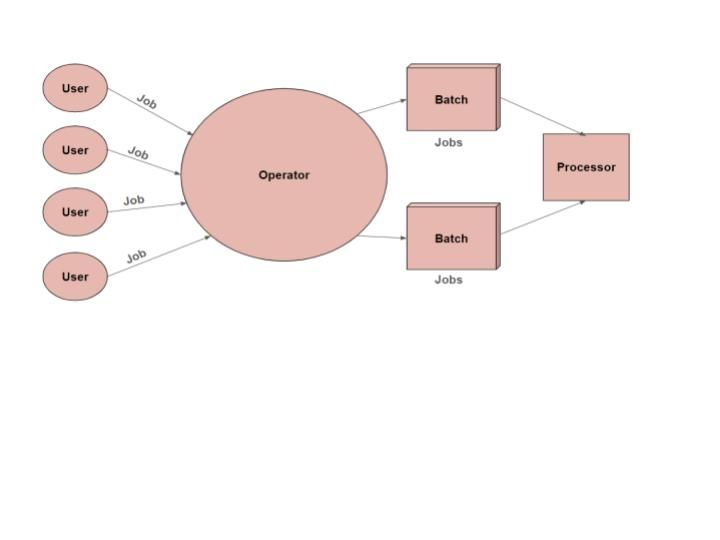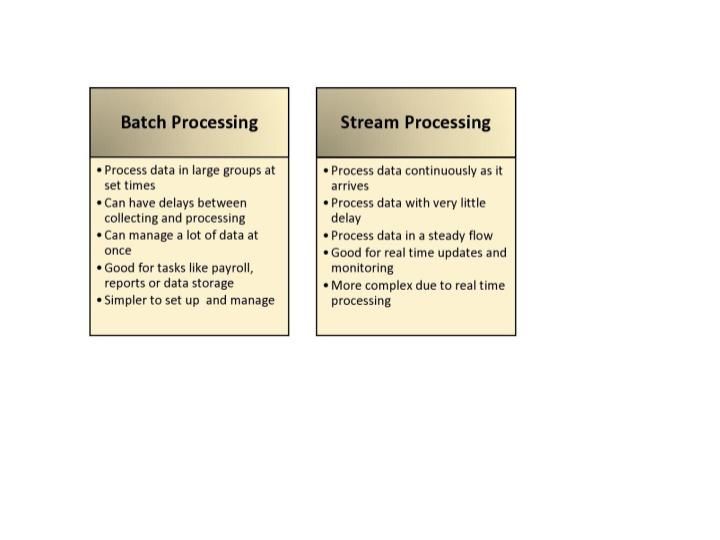Understanding Batch Processing: A Beginner’s Guide

Understanding Batch Processing: A Beginner’s Guide
Have you ever wondered how systems deal with large amounts of data without getting overwhelmed? A common way of managing this massive data is called batch processing. This method takes a vast volume of data and breaks it into smaller chunks, making it easier to handle. Instead of trying to do everything simultaneously, batch processing allows systems to work on tasks step by step, keeping things running smoothly.
Let’s discuss batch processing in further detail.
 Figure 1: Batch processing
Figure 1: Batch processing
What is Batch Processing?
Batch processing is a technique of completing several jobs or activities together in one group or “batch” instead of handling them separately. This approach is frequently applied in computing and data processing, particularly when dealing with large volumes of data. Unlike real-time processing, batch processing accumulates work over a period of time and processes it all at once at a scheduled time. This method can be useful for activities that do not need regular feedback or any form of immediate interactivity.
Batch processing is normally applied when processes or activities require multiple iterations. For instance, it is used in the payroll system where all employees' organizational data are obtained at a particular time interval at one go rather than handling each employee's data individually during their work hours. This method optimizes both time and resources by allowing the system to process the entire batch at once, enabling greater efficiency and improvements in the overall handling of data.
How Does Batch Processing Work?
 Figure 2: How Batch Processing Works
Figure 2: How Batch Processing Works
The batch-processing process generally follows these steps:
Collect Data
First, data is gathered from different sources like databases, external files, or other systems. Once collected, it's organized into batches, which helps group related information together. This organization makes the next steps easier, especially when working with large amounts of data.
Prepare Data
After collection, the data needs to be prepared. This step involves cleaning up any errors or inconsistencies, checking the data to ensure accuracy, and ensuring everything is formatted consistently. Proper preparation is important because it ensures the data is ready for smooth processing.
Process Data in Batches
Once the data is ready, it’s processed in batches. Each batch contains a smaller portion of the overall data. Tasks like calculations, sorting, and filtering are applied to each batch, making it easier to manage large amounts of data efficiently.
Handle Errors
Errors can occur during processing due to data issues or system failures. When that happens, the system catches these errors, logs them, and notifies administrators. Sometimes, the system will try processing the batch again to keep things running smoothly.
Generate Results
Results are generated after each batch is processed. These could be reports, updates to databases, or summarized information. The processed data can also be saved for future analysis or shared with other systems, ensuring valuable insights are not lost.
Post-Processing and Cleanup
Once all the batches are processed, final tasks like generating reports or archiving the data are performed. Any temporary files created during processing are cleaned to free up system resources and keep the environment running efficiently.
Schedule Tasks
Batch processes are often scheduled to run during off-peak hours to minimize any impact on other applications or users. Systems can work efficiently without affecting regular operations by scheduling tasks during quieter times.
Comparison with Stream Processing and Real-time Processing
Batch processing is a method for handling large volumes of tasks in groups, and it differs significantly from stream and real-time processing. Here is an in-depth comparison:
Batch Processing vs Stream Processing
Batch processing and stream processing are both key methods for managing data, each suited to different needs. The main difference between them is their approach to handling data. Batch processing processes large volumes of data at scheduled intervals, making it suitable for tasks that do not require immediate results. In contrast, stream processing continuously processes data as it arrives, enabling real-time responses. Batch processing is ideal for scenarios where speed isn't a priority, while stream processing is essential for applications demanding fast, real-time insights.
 Figure 3: Visual Comparison of Batch and Stream Processing
Figure 3: Visual Comparison of Batch and Stream Processing
Batch Processing vs Real-Time Processing
Real-time processing and batch processing are suited for different operational needs. Real-time processing deals with data instantly as it arrives, making it perfect for applications that need immediate feedback, like live monitoring or transaction processing. This approach requires advanced systems to manage the constant flow of data.
On the other hand, batch processing collects data over time and processes it in large groups at scheduled intervals. It's ideal for tasks that don’t need instant results, such as generating reports or handling large data imports, and is often more efficient for managing large volumes of data.
 Figure 4: Visual Comparison of Batch and Real-Time Processing
Figure 4: Visual Comparison of Batch and Real-Time Processing
Benefits of Batch Processing
Batch processing offers several advantages, such as efficient handling of large data volumes and optimized resource use. The following list highlights the key benefits:
Efficiency in Handling Large Volumes: Batch processing can handle large amounts of data efficiently, making it ideal for tasks like generating reports or processing bulk data updates.
Resource Optimization: Batch processing enables tasks to be scheduled during off-peak hours, optimizing system resources and minimizing performance impacts during high-demand periods.
Cost-Effectiveness: Since it processes data in bulk, it can be more cost-effective for large-scale operations, reducing the need for continuous system engagement.
Simplicity: Batch processing is typically more straightforward to manage than real-time systems, as it doesn't require the complex infrastructure needed to handle a continuous data flow.
Challenges of Batch Processing
The list below outlines the main challenges associated with batch processing:
Delay in Results: Results are available only after the entire batch is processed, which can be a drawback for applications that need immediate feedback or real-time information.
Complex Error Handling: Errors in batch processing can be more challenging to identify and correct since they may only become apparent after the batch has been processed, potentially affecting large volumes of data.
Scalability Issues: As data volumes grow, the size of batches and processing times may also increase, leading to scalability issues and longer processing times.
Batch Processing Use Cases
Batch processing is often used in scenarios where managing large volumes of data efficiently is crucial. Here are a few common examples:
Monthly Financial Reports: Creating detailed financial reports at the end of each month by aggregating and analyzing data from various sources. This helps summarize the company's financial status over a defined period.
Payroll Processing: Handling the calculation of employee salaries, benefits, and deductions for an entire pay period, typically done on a bi-weekly or monthly basis.
End-of-Day Transactions: Updating account balances and generating summaries by processing all transactions from the day in banking systems or retail environments.
System Backups: Performing regular backups of entire databases or file systems to ensure data is securely stored and can be restored if needed.
Customer Invoicing: Generating and sending invoices to multiple customers simultaneously, often done in bulk for efficiency in billing cycles.
Batch Processing FAQs
What is batch processing and how does it work?Batch processing involves collecting data at various intervals and processing it in large groups or "batches". This is perfect for tasks that are not necessarily time-sensitive, like running reports that may be monthly or data imports that take time to process. Batch processing operates by setting defined intervals, during which large volumes of data are systematically processed without the need for constant human intervention. This method is especially valuable for efficiently optimizing the handling of large datasets.
How does batch processing differ from real-time processing?Batch processing handles large volumes of data at specific times. Hence, the results will only be available after all the batches have been processed. On the other hand, real-time processing deals with the data on an ongoing basis and can deliver immediate responses. Real-time processing is, therefore, more appropriate for autonomous applications where the responses are immediate, such as through a monitoring system or online transaction processing. Real-time systems can process data in real-time, allowing for real-time output with proper and immediate feedback.
What are typical use cases for batch processing?Batch processing is usually used for activities such as generating monthly, weekly, or daily reports, preparing employee checks, and closing accounts, etc. It is also employed in creating system backups and handling large volumes of data by processing it in sizable batches rather than continuously.
Can batch processing be automated, and if so, how?Batch processing can be automated by using several tools and software. Part and batch jobs can be automated using automation tools and scheduling scripts that can be programmed to frequently run batch jobs during pre-scheduled times without necessarily requiring user interaction. Handling and processing batch tasks becomes easier when specific tasks are coded and automated since it makes it easy to complete them at the required time and in the right manner. This is especially useful in scenarios where manual handling would be impractical, such as when processing large volumes of data.
What are examples of batch processing?Batch processing is commonly used to streamline tasks and enhance efficiency across various industries. For instance, credit card companies use batch processing by generating a single monthly bill for customers, summarizing all transactions during that period. Instead of writing different bills for each transaction, customers will receive a single bill containing all the necessary information for the entire month. The manufacturing industry is another example where batch processing may be used during mass production, where large quantities of similar items are produced in a single run.
Further Resources
- What is Batch Processing?
- How Does Batch Processing Work?
- Comparison with Stream Processing and Real-time Processing
- Benefits of Batch Processing
- Challenges of Batch Processing
- Batch Processing Use Cases
- Batch Processing FAQs
- Further Resources
Content
Start Free, Scale Easily
Try the fully-managed vector database built for your GenAI applications.
Try Zilliz Cloud for Free